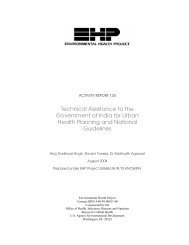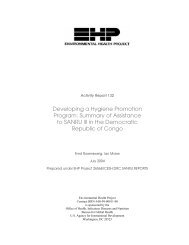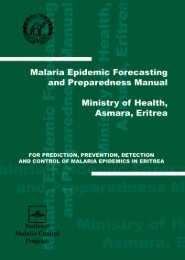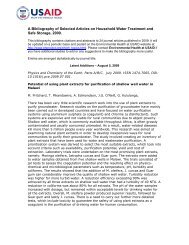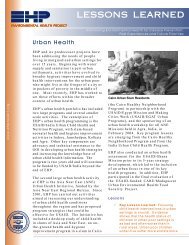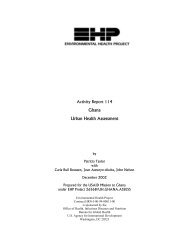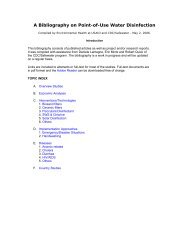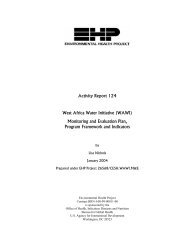Chlorine Residual Testing Fact Sheet
Chlorine Residual Testing Fact Sheet
Chlorine Residual Testing Fact Sheet
You also want an ePaper? Increase the reach of your titles
YUMPU automatically turns print PDFs into web optimized ePapers that Google loves.
2. Test-tube DPD color comparatorThe Lamotte Company developed a rapid presence/absence test kit for free chlorine residual inresponse to the 2004 tsunami in Indonesia. The test tube color comparator uses DPD (N,Ndiethyl-p-phenylene diamine) tablets that causes a color change to pink in the presence ofchlorine. To use the kit, users add 5 mL of water to the test tube, add one rapidly dissolvingDPD-1R tablet, and compare the results to a color chart. This kit combines the simplicity of thepool test kits, with the benefit of testing for free chlorine residual instead of total chlorineresidual. To use this kit to measure total chlorine, a DPD-4R tablet can be added instead of theDPD-1R tablet to the water sample, or a DPD-3R tablet can be added to the sample water afterthe DPD-1R tablet has been added and the free chlorine residual has been read. Although thetest kit is not available as a package from Lamotte, the individual components (test tube, DPDtablets, and color chart) can be ordered individually. Test kit instructions and part numbers canbe found at: http://www.lamotte.com/pages/common/pdf/instruct/3529.pdf.Benefits of the test tube kit are:• Low cost• Very easy to use• Measurement of free chlorineDrawbacks of the test tube kit are:• Generally not reliable quantitative results• Lack of calibration and standardizationCost and Ordering InformationThe kit parts are available from the Lamotte Company (www.lamotte.com) for a cost ofapproximately $5 for both the test tube and color comparator chart, and approximately $70 for1,000 DPD tablets.<strong>Chlorine</strong> <strong>Residual</strong> <strong>Testing</strong> <strong>Fact</strong> <strong>Sheet</strong>, CDC SWS Project, safewater@cdc.gov 6
3. Color wheel test kitsColor wheel test kits also use DPD tablets or powder that, when added to water with free or totalchlorine present in it, cause a color change to pink. The color wheel test kits are more accuratethan the pool test kits / test tube DPD color comparators and simpler and less expensive thandigital meters. This is because users measure the intensity of the color change, as compared witha sample of water to which no DPD has been added, using a color wheel to visually match thecolor change to a numerical reading. The test kit can be used to measure either free chlorine ortotal chlorine, or both, generally within a range of 0-3.5 mg/L, equivalent to 0-3.5 ppm (parts permillion). Please note that DPD tablets and powders are company specific, and that using onecompany’s test kit with another company’s DPD tablets is not recommended. Also note thatalthough all DPD-1 tablets measure free chlorine, there is variation between companies as towhether the total chlorine tablet is added to the same sample water the free chlorine is tested inor whether it is added to fresh sample water.Benefits of the color-wheel test kits are:• Accurate quantitative readings if used correctly• Low costDrawbacks of the color-wheel test kits are:• Potential for user error• Lack of calibration and standardizationCost and Ordering InformationColor wheel test kits can be ordered from:Hach Company www.hach.com Part Number: CN-66 Approximately $44Lamotte Company www.lamotte.com Part Number: 3308 Approximately $55Additional DPD tablets or powders can be ordered as well, at a cost of approximately $70 per1,000 tablets or sachets.<strong>Chlorine</strong> <strong>Residual</strong> <strong>Testing</strong> <strong>Fact</strong> <strong>Sheet</strong>, CDC SWS Project, safewater@cdc.gov 7
4. Digital ColorimetersDigital colorimeters are the most accurate way to measure free chlorine and/or total chlorineresidual in the field in developing countries. To use the colorimeters: 1) a DPD-1 (free chlorine)or DPD-3 (total chlorine) tablet or powder is added to a vial of sample water that causes a colorchange to pink; and, 2) the vial is inserted into a meter that reads the intensity of the color changeby emitting a wavelength of light and automatically determining and displaying the colorintensity (the free or total chlorine residual) digitally. The range of the meters is generally 0-4mg/L, equivalent to 0-4 ppm (parts per million). Please note that DPD tablets and powders arecompany specific, and that using one company’s test kit with another company’s DPD tablets isnot recommended.Benefits of the digital colorimeters are:• Highly accurate readings• Fast results• EPA approvedDrawbacks of the digital colorimeters are:• Expense• Necessity of calibration with standards• Necessity for skilled operatorCost and Ordering InformationDigital colorimeters can be ordered from:Lamotte Company www.lamotte.comPart Number 3670-01 Approximately $350Standards: Part Number: 4140 Approximately $70Hach Company www.hach.comPart Number 5870000 Approximately $352Standards: Part Number: 2635300 Approximately $115Additional DPD tablets or powders can be ordered as well, at a cost of approximately $70 per1,000 tablets or sachets.<strong>Chlorine</strong> <strong>Residual</strong> <strong>Testing</strong> <strong>Fact</strong> <strong>Sheet</strong>, CDC SWS Project, safewater@cdc.gov 8
SUMMARY STATEMENTThe selection of which methodology to use to measure free and total chlorine can be complicatedand is dependent on a number of programmatic factors, including: 1) need for accuracy; 2) cost;3) number of samples to be tested; and, 4) how the data will be used. Some recommendationsfor which methodology to use based on different sampling goals are:Dosage <strong>Testing</strong> in a New Safe Water System Program:If the goal is dosage testing for a new SWS program, we highly recommend the use of the digitalcolorimeters. The accuracy of the digital meters is necessary to ensure the correct chlorinedosage is determined.Program Monitoring:If the goal is to determine whether users are treating water in their homes with the SWS, spotchecksin the home to sample the household water with pool test kits or test-tube DPD testing issufficient and provides a simple indicator of the presence or absence of chlorine in householddrinking water. Local household interviews or monitors can be taught to use these methods in 30minutes, and each test takes approximately 1-2 minutes in the household. Thus, it is possible toinclude this testing in large programmatic or national-scale surveys.Project Evaluation:If the goal is to determine if users are adding the correct amount of chlorine in the home, spotchecksin the home to sample the household water with the color-wheel kit provides morequantitative information than the presence/absence tests, while remaining relatively inexpensiveand easy to use. A 1-2 hour training is needed to teach local household interviews or monitors touse this method, and each test takes approximately 5 minutes in the household.If you have questions about chlorine residual testing, please contact safewater@cdc.gov.CDC as a branch of the federal government does not endorse products from specific companies. The above information isfor reference purpose only to describe the SWS project experience and represents, to the authors’ current knowledge, arange of available products to complete this sampling.<strong>Chlorine</strong> <strong>Residual</strong> <strong>Testing</strong> <strong>Fact</strong> <strong>Sheet</strong>, CDC SWS Project, safewater@cdc.gov 9




